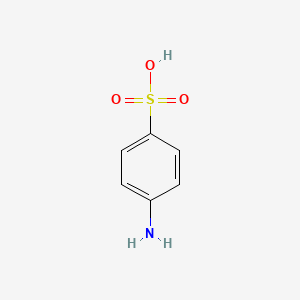

1. 4-aminobenzenesulfonic Acid
2. 4-aminobenzenethiol
3. 4-sulfanilic Acid
4. 4-sulfanilic Acid, Sodium Salt
5. 4-sulfanilic Acid, Zinc (2:1) Salt
6. Para-aminobenzenesulfonic Acid
1. 4-aminobenzenesulfonic Acid
2. 121-57-3
3. Sulphanilic Acid
4. P-aminobenzenesulfonic Acid
5. Aniline-4-sulfonic Acid
6. Aniline-p-sulfonic Acid
7. Sulfanilsaeure
8. Benzenesulfonic Acid, 4-amino-
9. Aniline-p-sulphonic Acid
10. P-aminophenylsulfonic Acid
11. P-anilinesulfonic Acid
12. Kyselina Sulfanilova
13. Chebi:27500
14. 4-sulfoaniline
15. Nsc 7170
16. 4-aminobenzene-1-sulfonic Acid
17. Chembl1566888
18. Nsc-7170
19. Mfcd00007886
20. Benzenesulfonic Acid, 4-amino-, Homopolymer
21. 434z8c2635
22. 71949-32-1
23. Sulfanilsaeure [german]
24. 4-sulfanilic Acid
25. Kyselina Sulfanilova [czech]
26. 129674-17-5
27. Ccris 4576
28. Sufanilic Acid
29. Hsdb 5590
30. 4-aminobenzenesulphonic Acid (sulphanilic Acid)
31. P-sulfanilic Acid
32. Einecs 204-482-5
33. P-sulfoaniline
34. Aniline P-sulfonic Acid
35. Ai3-15414
36. Sulfanilic Acid;
37. P-sulphanilic Acid
38. Unii-434z8c2635
39. 4-aminobenzenesulphonic Acid
40. Sulfanilic Acid, 99%
41. Sulfanilic Acid Anhydrous
42. 4-aminophenylsulfonic Acid
43. Bmse000726
44. Epitope Id:122241
45. Ec 204-482-5
46. P-aminobenzenesulphonic Acid
47. P-aminobenzene Sulfonic Acid
48. 4-aminobenzene-sulfonic Acid
49. Schembl24407
50. Sulfanilic Acid [mi]
51. 4-amino Benzenesulphonic Acid
52. 97675-28-0
53. Sulfanilic Acid, >=99.0%
54. Sulfanilic Acid [hsdb]
55. 1-aminobenzene-4-sulfonic Acid
56. 4-amino-1-benzenesulfonic Acid
57. Sulfanilic Acid, 98%, Tech.
58. Dtxsid6024464
59. Nsc7170
60. Sulfanilic Acid [usp-rs]
61. Zinc1530397
62. Nitrate Reagent B, For Microbiology
63. Bbl011603
64. Bdbm50443531
65. Stk661383
66. Sulfanilic Acid, Acs Reagent, 99%
67. Akos000118732
68. Am91128
69. Ncgc00090886-01
70. Ncgc00090886-02
71. Ac-12565
72. Vs-02984
73. Sulfanilic Acid [for Biochemical Research]
74. Mesalazine Impurity O [ep Impurity]
75. Sulfanilic Acid, P.a., 98.0-102.0%
76. Ft-0674701
77. S0120
78. Sulfadiazine Impurity B [ep Impurity]
79. U0107
80. Sulfadimidine Impurity F [ep Impurity]
81. C06335
82. E80415
83. Sulfadimethoxine Impurity D [ep Impurity]
84. Sulfamethoxazole Impurity D [ep Impurity]
85. Sulfanilic Acid, Vetec(tm) Reagent Grade, 99%
86. Q253746
87. Sulfanilic Acid, Puriss. P.a., >=99.0% (t)
88. J-004536
89. 4-aminobenzenesulfonic Acid 100 Microg/ml In Methanol
90. Sulfanilic Acid, Jis Special Grade, 99.0-100.5%
91. F0001-0346
92. Sulfanilic Acid, United States Pharmacopeia (usp) Reference Standard
93. Sulfadimethoxine Sodium For Veterinary Use Impurity D [ep Impurity]
94. Sulfanilic Acid, 99.0-100.5%, Suitable For Determination Of Nitroxide
95. Benzenesulfonic Acid, 4-amino-, Diazotized, Coupled With Dyer's Mulberry Extract
96. Benzenesulfonic Acid,4-amino-,diazotized,coupled With Dyer's Mulberry Extract
97. Sulfanilic Acid, Pharmaceutical Secondary Standard; Certified Reference Material
98. Benzenesulfonic Acid,4-amino-,diazotized,coupled With 5,5'-oxybis[1,3-benzenediol],sodium Salt
| Molecular Weight | 173.19 g/mol |
|---|---|
| Molecular Formula | C6H7NO3S |
| XLogP3 | -0.6 |
| Hydrogen Bond Donor Count | 2 |
| Hydrogen Bond Acceptor Count | 4 |
| Rotatable Bond Count | 1 |
| Exact Mass | 173.01466426 g/mol |
| Monoisotopic Mass | 173.01466426 g/mol |
| Topological Polar Surface Area | 88.8 Ų |
| Heavy Atom Count | 11 |
| Formal Charge | 0 |
| Complexity | 211 |
| Isotope Atom Count | 0 |
| Defined Atom Stereocenter Count | 0 |
| Undefined Atom Stereocenter Count | 0 |
| Defined Bond Stereocenter Count | 0 |
| Undefined Bond Stereocenter Count | 0 |
| Covalently Bonded Unit Count | 1 |
4-Aminobenzene sulfonic acid can be absorbed from the gastrointestinal tract. Absorption through the lungs appears to be possible; absorption of an intratracheally-instilled solution of 4- aminobenzene sulfonic acid has been detected in the rat. Accumulation does not take place in mammals; excretion after oral administration mainly occurs within 24 hr. 4-Aminobenzene sulfonic acid is excreted either unchanged or as the N-acetyl metabolite, in the urine in rabbits, and in the urine and the feces in rats.
Anonymous; Toxikologische Bewertung. Heidelberg, Berufsgenossenschaft der chemischen Industrie 252: 27 (1993)
WHEN SULFANILIC ACID WAS ADMINISTERED ORALLY TO RATS, 53% OF THE ADMINISTERED DOSE WAS FOUND IN THE URINE.
SCHELINE RR, LONGBERG B; THE ABSORPTION, METABOLISM AND EXCRETION OF THE SULFONATED AZO DYE, ACID YELLOW, BY RATS; ACTA PHARMACOL TOXICOL 23(1) (1965)
YIELDS P-ACETAMIDOBENZENESULFONIC ACID IN RABBIT: DANIEL, JW, TOXICOL APPL PHARMAC, 4, 572 (1962). /FROM TABLE/
Goodwin, B.L. Handbook of Intermediary Metabolism of Aromatic Compounds. New York: Wiley, 1976., p. S-14
Many idiosyncratic non-steroidal anti-inflammatory drugs (NSAIDs) cause GI, liver and bone marrow toxicity in some patients which results in GI bleeding/ulceration/fulminant hepatic failure/hepatitis or agranulocytosis/aplastic anemia. The toxic mechanisms proposed have been reviewed. Evidence is presented showing that idiosyncratic NSAID drugs form prooxidant radicals when metabolized by peroxidases known to be present in these tissues. Thus GSH, NADH and/or ascorbate were cooxidised by catalytic amounts of NSAIDs and hydrogen peroxide in the presence of peroxidase. During GSH and NADH cooxidation, oxygen uptake and activation occurred. Furthermore the formation of NSAID oxidation products was prevented during the cooxidation indicating that the cooxidation involved redox cycling of the first formed NSAID radical product. The order of prooxidant catalytic effectiveness of fenamate and arylacetic acid NSAIDs was mefenamic acid>tolfenamic acid>flufenamic acid, meclofenamic acid or diclofenac. Diphenylamine, a common moiety to all of these NSAIDs was a more active prooxidant for NADH and ascorbate cooxidation than these NSAIDs which suggests that oxidation of the NSAID diphenylamine moiety to a cation and/or nitroxide radical was responsible for the NSAID prooxidant activity. The order of catalytic effectiveness found for sulfonamide derivatives was sulfaphenazole>sulfisoxazole>dapsone>sulfanilic acid>procainamide>sulfamethoxazole>sulfadiazine>sulfadimethoxine whereas sulfanilamide, sulfapyridine or nimesulide had no prooxidant activity. Although indomethacin had little prooxidant activity, its major in vivo metabolite, N-deschlorobenzoyl indomethacin had significant prooxidant activity. Aminoantipyrine the major in vivo metabolite of aminopyrine or dipyrone was also more prooxidant than the parent drugs. It is hypothesized that the NSAID radicals and/or the resulting oxidative stress initiates the cytotoxic processes leading to idiosyncratic toxicity.
PMID:12399153 Galati G et al; Chem Biol Interact 142 (1-2): 25-41 (2002)